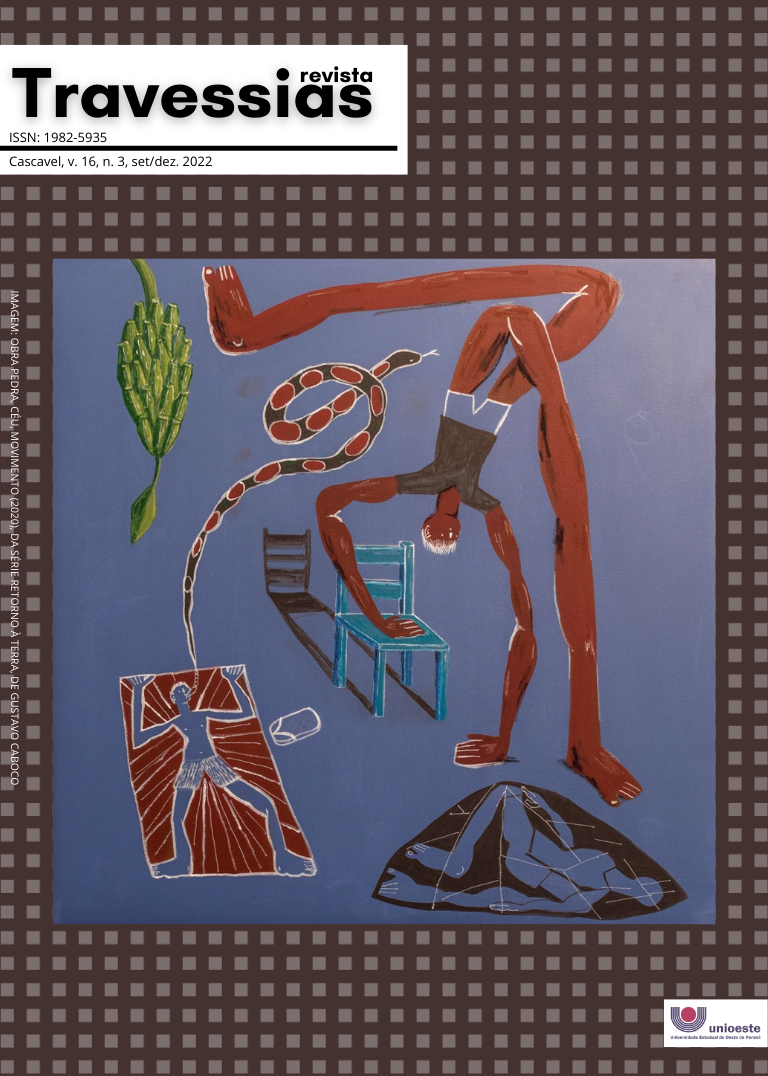Performance in music and beyond music
an analysis of Teto Preto`s song Pedra Preta
DOI:
https://doi.org/10.48075/rt.v16i3.30058Keywords:
Musica Analysis, Popular music, Electronic music, Performance, Teto PretoAbstract
This article engages with an analysis - which seeks to extrapolate the musical universe - of the song Pedra Preta, written by the band Teto Preto, an electronic music group whose founder and frontgirl is the multi-artist Laura Diaz. The analysis was carried out based on several interviews, written or on in video, that Laura Diaz gave in 2019 and through six different interpretive biases: lyrics; melody and harmony; vocals; percussion and rhythm; instruments, sound and ambience; video clip. In musical biases, traditional analytical parameters were used, but not in a disintegrated way to what really matters in the case of the song in question: the symbolic context. At the end of the analysis, some issues deserve to be highlighted: the song has strong influences from MPB ranging from harmony to Laura Diaz's voice; the song is built from sounds in a logic of layers, where a single element, most of the time, would lose its meaning; the band Teto Preto and, therefore, their songs, are full of meanings. Therefore, it is not possible to fully understand the band's multiartistic proposal without having a prior understanding of some aspects, such as its origins and guidelines. Finally, we conclude that the analysis of songs like Pedra Preta requires a transdisciplinary look. which does not exclude the musical aspect, but systematically elaborates it, since the music is the supporting column of all the other structural pillars of the song in its process of signification.
Downloads
References
ALBINI, Alexandre. Alataj entrevista Teto Preto. Alataj, 28 de out. de 2019. Disponível em: https://alataj.com.br/entrevistas/teto-preto. Acesso em: 30 de out. de 2022.
BARROSO, Renato Régis. Pajubá: o código linguístico da comunidade LGBT. 2017. 153 f. Dissertação (Mestrado em Letras e Artes), Universidade Estadual do Amazonas, Manaus, 2017.
BLACKGATE CO. Blackgate Entrevista: Teto Preto | Parte 1. Youtube. 19 de jan. de 2019. Disponível em: https://www.youtube.com/watch?v=2pnOu7QVx8w. Acesso em: 30 de out. de 2022.
GONÇALVES, Fábio da Silva; OLIVEIRA, Daniel Coelho de. Entre o divino e o dinheiro: análise de serviços magísticos em um terreiro de Candomblé. Interações, Campo Grande, v. 23, n. 1, p. 149-164, jan./mar. 2022.
GUERRA, Renan. Entrevista: Teto Preto. Scream & Yell, 10 de jan. de 2019. Disponível em: http://screamyell.com.br/site/2019/01/10/entrevista-teto-preto/. Acesso em: 30 de out. de 2022.
MAMBA NEGRA. Teto Preto: Pedra Preta. Youtube, 22 de nov. de 2018. Disponível em: https://www.youtube.com/watch?v=5nflC6GkQ8>. Acesso em: 30 de out.de 2022.
MOORE, Allan F. Song Means: Analysing and Interpreting Recorded Popular Song. Farnham: Ashgate, 2012.
PEDRA Preta. Bandcamp, 2018. Disponível em: https://mambarec.bandcamp.com/track/pedra-preta. Acesso em: 30 de out. de 2022.
SLOAN, Nate; HARDING, Charlie. Switched on Pop: How Popular Music Works, and Why It Matters? Oxford: Oxford University Press, 2020.
Downloads
Published
How to Cite
Issue
Section
License
Copyright (c) 2022 Authors keep the copyright and grant the journal the right of first publication, with the work simultaneously licensed under the Creative Commons Attribution License (CC-BY-NC-SA 4.0), which allows sharing the trial with acknowledgment of authorship and initial publication in this journal.

This work is licensed under a Creative Commons Attribution-NonCommercial-ShareAlike 4.0 International License.
Creative Copyright Notice
Policy for Free Access Journals
Authors who publish in this journal agree to the following terms:
1. Authors keep the copyright and grant the journal the right of first publication, with the work simultaneously licensed under the Creative Commons Attribution License, which allows sharing the trial with acknowledgment of authorship and initial publication in this journal.
2. Authors are authorized to take additional contracts separately, for non-exclusive distribution of the work version, published in this journal (eg publish in institutional repository or as a book chapter), with acknowledgment of authorship and initial publication in this journal.
3. Authors are allowed and encouraged to publish and distribute their work online (eg in institutional repositories or on their personal page) at any point before or during the editorial process, as this can generate productive changes, as well as increase both impact and citation of the published trial (See The Effect of Free Access).
Creative Commons License
This work is licensed under a Creative Commons Attribution–NonCommercial-shareaswell 4.0 International License, which allows you to share, copy, distribute, display, reproduce, completely or part of the work, since there is no commercial purpose, and authors and source are cited.



